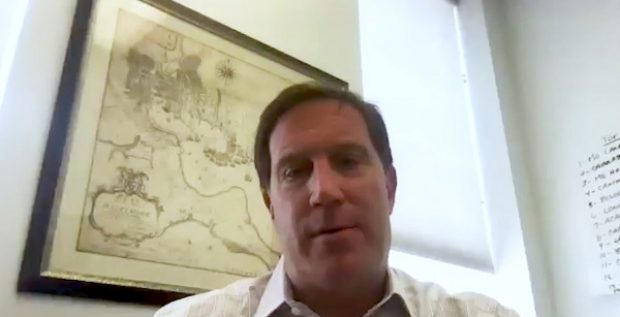Ron Rock is the CEO and founder of Point.io, headquartered in Philadelphia, PA. Point.io offers customizable, pre-made solutions that allow enterprises to build moble-ready apps easily and efficiently. The company provides a comprehensive app creation and management platform that covers every step of the process, from composition to deployment and hosting. Typical uses of Point.io’s solutions include remote collaboration, expense reports, retail, event marketing, and many more. The company has also partnered with software providers such as Citrix, making integration with customers’ existing technology even easier. Prior to founding Point.io, Ron Rock was the CEO and founder of Knowledge Rules, a business process management consulting firm he sold to Accenture in 2010.
Ron Rock spoke with Jeff Mack, Executive Managing Director at Newmark Grubb Frank, for this interview.
JEFF MACK: Tell us how Point.io works.
RON ROCK: Point.io builds situational apps for work, specifically the enterprise. What do I mean by situational apps? We’re all used to using situational apps in our everyday life. We’ve become so accustomed to downloading apps from the App Store, and they do very specific things: we have an app that tells us what time to get up in the morning, an app that tells us how to get from point A to point B, an app that tells us how many steps we took today, an app to order my latte. They’re not an application for my entire day, but rather apps that help me get something done, very specific to get a task done. Why can’t we do the same thing at work? There are a lot of challenges as to why enterprises haven’t been able to build those kind of apps to enter my time, approve a contract, sign an NDA, et cetera. So we’re building apps for work to allow people to get real work done.
Q. Can you give us an example?
A. One good example is the Lien Release app. In the construction industry, you hire a general contractor. The general contractor has lots of subcontractors, and often those subcontractors have additional subcontractors. Every one of those contractors is entitled to put a lien on the owner’s property if they claim they haven’t been paid. So, a contractor, when they submit their invoice to the property owner, has to sign a lien release to get paid. We’re building an app right now that allows you to distribute the lien release with DocuSign, rolling all of that up. If I’m a subcontractor and I’m waiting for that $10,000, I can’t get paid until I’ve signed that lien release app, so it’s something people are very excited to do.
Q. I’ve noticed many of your products have “API” in their names. What role does API play in the process?
A. We tend to name our products starting with “API” and the reason for that is we talk about the API economy. For people that don’t know what the API is, the analogy I’d like to use is it’s the outlet on the wall for your electricity, and the fact that you buy something at Best Buy with a UL tag on it. That UL tag is a contract—it says “we agree that if you conform to the rules that we the power company declare, as long as you play by the rules when you plug it in, we guarantee it’s going to work.” Well, APIs are the same thing for systems talking to systems—for your smartphone talking to backend systems. APIs are clearly defined protocols that allow two systems to work together, and it’s the way that people build mobile apps.
APIflow is an API-enabled BPM [business process management] engine. I told you that with Knowledge Rules, we were in the BPM space. We’ve been in BPM for the last 25 years, my partners and I, and so APIflow is revolutionary in a way. It allows mobile developers to easily build process into the mobile apps without being process experts.
Q. Could you take us through some of the most popular apps you’ve built?
A. In describing some of the apps that Point.io has built, there’s a common theme across all of them, which is they’re all about getting real work done. They’re apps that you would use at work, not in your personal life. Our apps tend to be situational, which means that things like the NDA app are about helping large firms manage signing their NDA. If you think about it today, most of us use email as our collaboration tool. We go back and forth on an NDA. You make changes, I make changes, and ultimately, when it’s done, we need to sign it. How do we sign it Today we print it up, we sign it, and who’s got a scanner? So, now we put it on a table and we try to focus it, we take a picture of it, and then we send it to ourselves to make sure that it worked, and then I send it back to you and typically you do the same thing. We built an app right now that simply pulls the document from wherever it may be—SharePoint, Documentum, FileNet, Box, Dropbox—we integrate it with DocuSign for the signature, and we seamlessly allow you to sign that document and store it wherever you need to store it.
On the Press Release app, it’s a very similar process. Often, press releases are iterated between the client and the PR firm. The scary part is often, after all that collaboration, the wrong release goes out. So we have the ability to agree that once a press release is ready to go, we both sign it. The only one that gets released is the one that was signed.
On the Board Room app, that’s really more of an application, and I want to talk a little bit about apps versus applications. Apps are very specific. Sign an NDA, watch that press release, enter my time. A Board Room application was something we built for one of our largest clients: it’s an application that allows them to run the entire board meeting. It’s got all of the documents locked away in a very secure place. Imagine publically traded companies with their board content being suddenly out on the Internet. It’s got voting, it’s got a reading room, it’s got all the capabilities of tasks, so that every board member knows where to get what information regardless of whether they’re sitting in Hong Kong or sitting here in Philadelphia. That’s the power of a complete application that you can build on our platform. I use that as the far extreme. At the other end of the extreme, you can build a throwaway app—an app that you’re going to use just for a client, just for a prospect. Rather than sending them a proposal competing for a piece of business, send them a link to an app, and the app would have your proposal, your picture, your LinkedIn profile, your bio, a document repository with DocuSign link to it. So, everything from complete applications, which can be hundreds of thousands of dollars and months to build, to a throwaway app that I configured in an hour and I deployed.



















